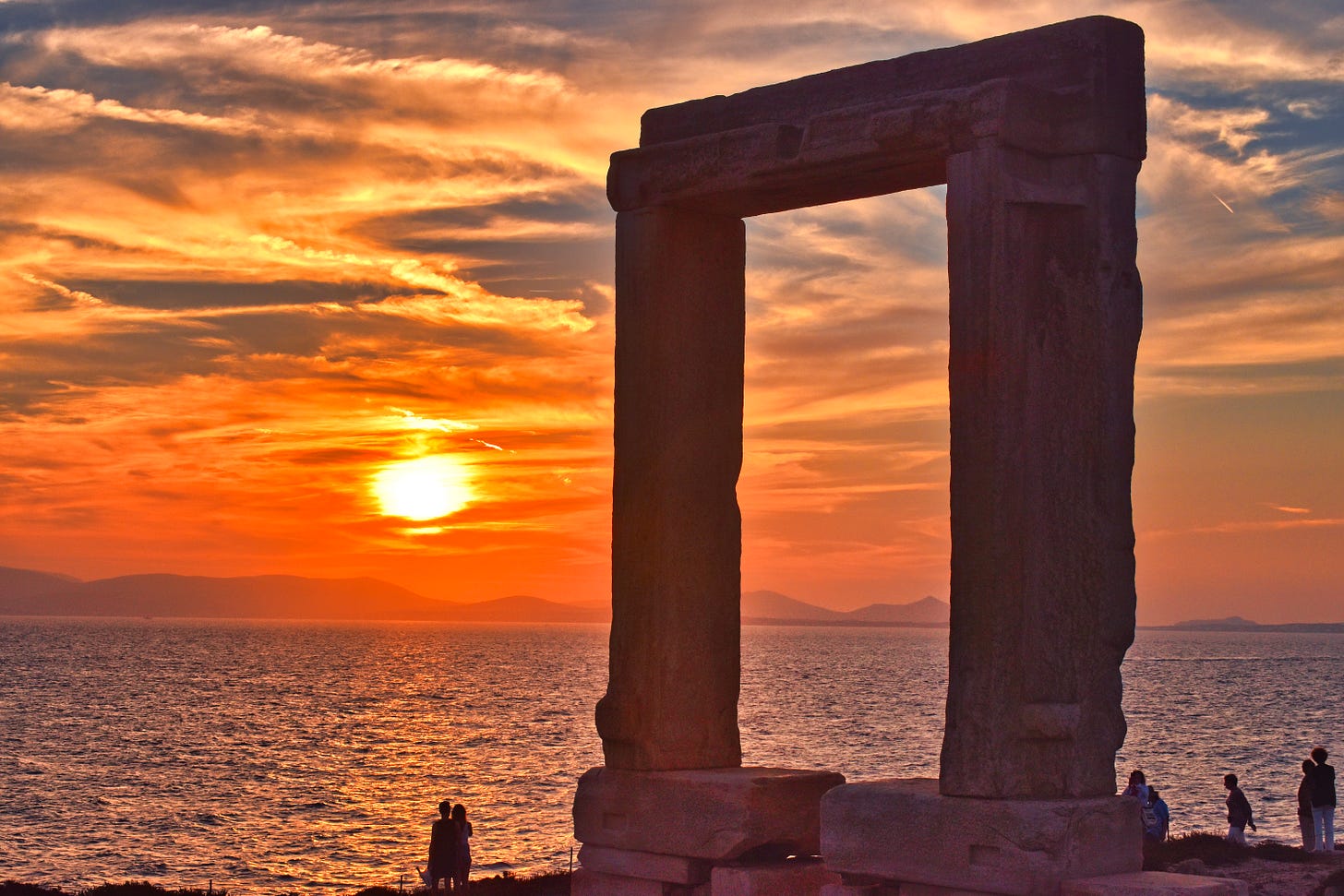The Island That Calls You to Stay
A journey through the light, flavors, and quiet rhythms of an island that lingers long after you leave.
The Aegean cradles me in her arms, my lips tasting of salt, the sky above a brilliant Cycladian blue. I can hear the muffled grind of ship's screws and sea-life crawling on the floor of the lagoon as I float effortlessly in the shadow of Apollo's Gate. This, I know, will be a memory I will return to frequently in the years to come and one of the reasons I wanted to visit the island. The island has already settled into me, sneaking into my heart before I even know it is there.
But before I floated weightless in the Aegean’s quiet embrace, my wife and I had first glimpsed Naxos from the deck of the Blue Star ferry, watching the island unfold before us as the captain swung the ship with a practiced 180-degree pivot, perfectly aligning the ramp against the end of the tarmac. Late afternoon light draped the island in hues of honey and blue, like chiffon caught on a breeze, already fading into the amber blush of dusk. Drawn by promises of crystalline waters and the famous gate perched high on its bluff, watching over the sea on one side and the harbor on the other, we approached Naxos with eager eyes. Blue shutters and bursts of pink bougainvillea played a fleeting game of hide and seek through narrow alleys, disappearing and reappearing as we moved closer to shore. My wife and I disembarked in quiet anticipation, the cool air carrying the promise of timeless evenings beneath Apollo’s Gate and days spent exploring an island alive with myth. This island, unassuming, ancient, alive with whispers of history, felt like a reprieve. Less polished than Santorini, less restless than Mykonos, Naxos is the Cyclades’ soul laid bare. Homer may have lingered here too long, I thought—not for the pull of sirens or the fury of storms, but because this place calls you to pause, to anchor, to remember what it feels like to belong.
After settling into our hotel, we walked to Apollo’s Gate, where the ancient stone framed a masterpiece of nature. The setting sun cast its golden light through the storied rectangle, illuminating the rugged stone and tracing the silhouettes of couples gazing at the sea below. The breeze carried whispers of salt, while the murmur of travelers speaking in hushed tones mingled with the gentle rhythm of waves against the harbor. Children darted between the rocks as we sat on the stones, watching the sun linger in one direction and the moon rise in the other, their light brushing the surrounding grass and flowers with hues of rose and silver. The air felt weighty with time, with history, as we sat among other travelers, strangers bound by awe, united in reverence for the moment where we decided to stop, to listen, and to belong.
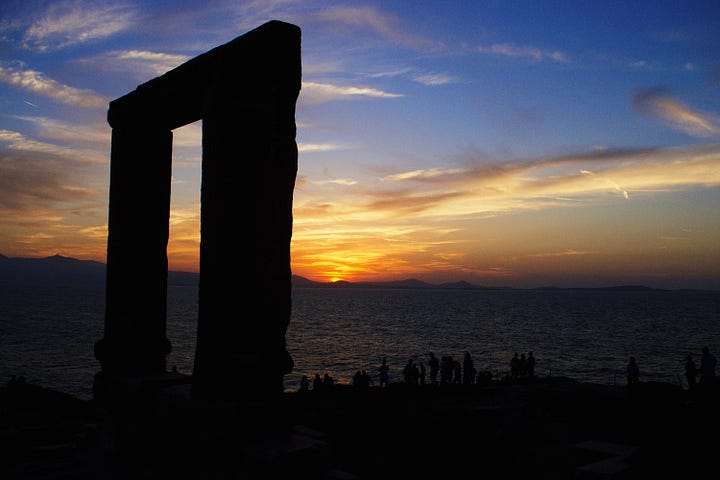
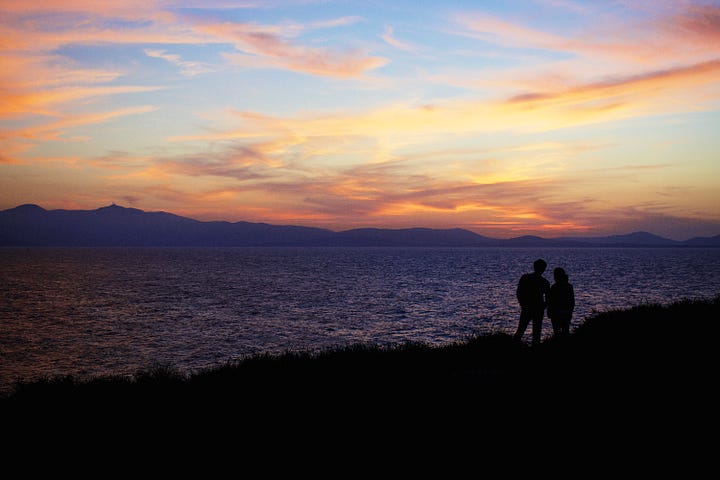
Reluctantly, we made our way down the bluff in search of dinner and a glass of raki, watching as evening spread across the harbor. As the evening's shadows lengthened across the white-washed village, my wife and I found ourselves on the second floor of a harbor-side taverna with a view of Apollo’s Gate. We took a seat at a small table on a balcony overlooking the water and ordered. Soon, we were presented with a platter of seafood, zucchini fritters, and a plate of saganaki, which hissed and spit in the small, scalding hot cast-iron skillet before being set aflame by the waiter using a bit of ouzo.
I took a bite, and the world narrowed to the salt, the heat, the slow bloom of anise from the flambé. The cheese was rich and salty, both creamy and just crumbly enough, the warmth of anise lingering from the ouzo flame. As I savored each bite, gratitude washed over me—gratitude for this meal, for this island, for the weight of history pressing softly against the present. These were the simple pleasures that made travel so valuable. The memories we can return to when our daily life begins to feel monochrome and desaturated.

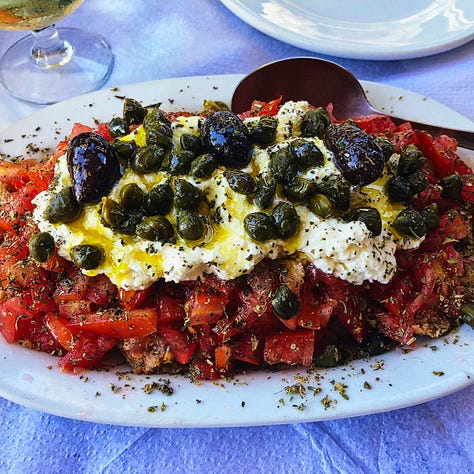

Paying the bill, we made our way back to the hotel with a small bottle of Metaxa, a new-to-us spirit that we had discovered earlier in the day. As the last embers of the sunset faded, we lingered on our balcony, sipping the local brandy, watching a lone sailboat carve its way home across the darkening sea. The hush of night folded around us, lulling the island into the deep and measured breath of sleep.
Morning arrived in quiet strokes of silver and gold, the air still cool from the night but laced with the hint of a warm afternoon. I slipped out while Rebecca prepared for the day, following the gentle pull of a bakery we had glimpsed the day before. The water, iridescent and impossibly blue, stretched lazily beyond the stark white buildings that framed the harbor. I walked along the curve of the protected bay, the hush of morning briefly interrupted by the jarring clang of a tiny garbage truck, its mechanical arm lifting bins, emptying them into the waiting container before retreating into the quiet.
Turning onto the main shopping street of the town, the bakery stood on the corner, its windows full of promise. A bell rang as I entered, and I was met with a rush of warmth, the intoxicating perfume of butter and yeast wrapping around me. Behind the glass, golden pastries gleamed like treasure, waiting to be chosen. Outside, Naxos awakened slowly, but here, inside this little shop, the day was already in full bloom.
With coffee and breakfast in hand, I wandered back to the hotel, eager to lose myself in the warren of whitewashed alleys, where charcoal stone streets curved beneath bursts of pink blossoms spilling over doorways and terraces. We sat quietly at the same table as the night before, the morning hush brushing past us, soft and fleeting, as we sipped our coffee and shared a flaky, still-warm pastry. We broke it apart between sips of coffee, watching as the last of the fishing boats slipped from the harbor, their bows tilting toward deeper waters, toward the promise of the day’s first haul.
Finishing our coffee, we stepped out of the hotel, drawn into the first small street we came across—the town pulling us deeper and deeper into its sun-bleached maze. Bougainvillea exploded in crimson against marble and stone buildings, blue doors and white-bordered granite streets beckoning us deeper into the city’s embrace. A chorus of indifferent cats watched from their perches, tails flicking as we meandered mapless through the alleys and passageways. Climbing higher above the port, we eventually—and happily—arrived at the top of a large hill and the Archaeological Museum of Naxos, where we viewed the tile mosaics while the town unfurled beneath us.

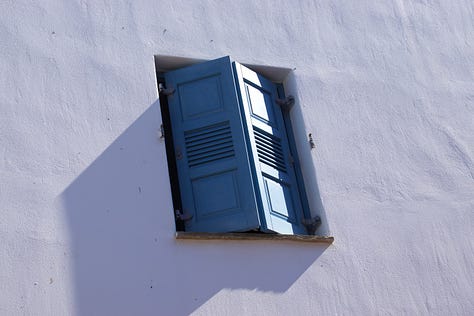

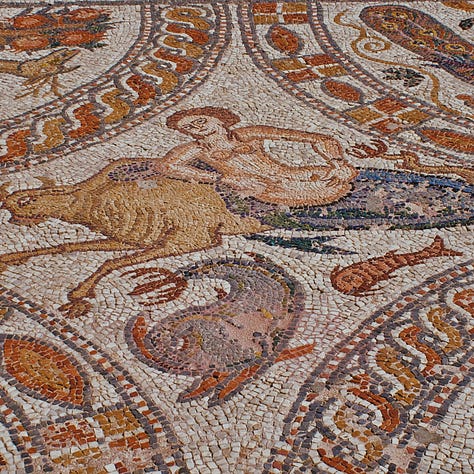


After exploring the museum and once again losing ourselves in the whitewashed warren—this time descending instead of climbing—we emerged onto the street lining the harbor. Just ahead, a tiny white church floated on a cement island, accessible only by small boat. Outside the waterfront restaurants, octopus draped over lines like yesterday’s wash, slowly tenderizing under the afternoon sun in preparation for the evening’s service. We chose a table with a view of the church and lingered over a gloriously simple meal of horiatiki, shawarma, and golden-crisp Greek potatoes, their edges glistening with olive oil and flecked with tiny diamonds of salinity.
We wished we could stretch the meal into the soft light of late afternoon and stay in the rhythm and lazy cadence the island had instilled in us, but our bags waited, and a ferry was set to take us on the next leg of our own odyssey with Naxos still folded into us.
Of Tides & Thyme is open to all, its stories small lanterns lighting the dark. If this one warmed your heart, help keep the flame alive. A single click on the button below is all it takes—no account needed. No recurring subscriptions.
Recipe
Greek Saganaki
Saganaki is a delicious and simple Greek appetizer made with cheese and a few pantry staples. Here is a traditional recipe for making saganaki at home:
Ingredients:
1/4 cup all-purpose flour
8 oz Kasseri cheese. You can substitute with halloumi, Manchego, or paneer as well.
2 tablespoons olive oil
1/4 cup (2 ounces) ouzo
Instructions:
Slice the cheese lengthwise, 1/2-inch to 1-inch thick.
Sprinkle flour evenly over a large plate and dip the cheese in the flour, dredging until lightly coated on all sides.
In a small cast-iron or stainless steel skillet over high heat, heat the oil until it shimmers.
Carefully place the flour-coated cheese into the oil. Remember to lay the cheese in away from you.
Fry on one side about 2 minutes until golden and crisp. Then flip, again flipping away from you, and fry the other side another 2 minutes until golden and just starting to melt.
Remove from the heat.
Have a pot lid handy in case you need to cover the pan to suppress the flames and make sure that nothing is hanging over the pan.
Pour the ouzo over the cheese. DO NOT POUR DIRECTLY FROM THE BOTTLE.
Using a stick lighter or long match, carefully set the ouzo aflame.
As the cheese flambes, carefully shake the pan gently to help disperse the flame until extinguished and the alcohol is burned off.
Serve immediately.


